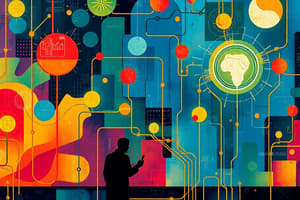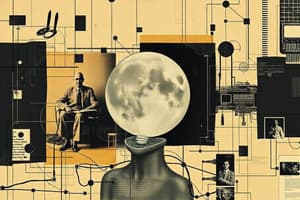Podcast
Questions and Answers
Low-cost computers and high-speed communication networks are key catalysts for the Information Age.
Low-cost computers and high-speed communication networks are key catalysts for the Information Age.
True (A)
The Samsung Galaxy S9 Plus is only capable of making phone calls.
The Samsung Galaxy S9 Plus is only capable of making phone calls.
False (B)
Self-driving cars are an example of emerging technologies in the Information Age.
Self-driving cars are an example of emerging technologies in the Information Age.
True (A)
Voice-activated digital assistants are considered obsolete technologies.
Voice-activated digital assistants are considered obsolete technologies.
Video streaming services are a milestone in networking.
Video streaming services are a milestone in networking.
In 1950, electronic digital computers were widely available and the internet was actively used.
In 1950, electronic digital computers were widely available and the internet was actively used.
Early mechanical calculators were primarily designed for accuracy and reliability.
Early mechanical calculators were primarily designed for accuracy and reliability.
The introduction of the cash register in department stores solved problems related to sales record accuracy.
The introduction of the cash register in department stores solved problems related to sales record accuracy.
Women were predominantly replaced by men in bookkeeping roles during the Gilded Age due to the adoption of calculators.
Women were predominantly replaced by men in bookkeeping roles during the Gilded Age due to the adoption of calculators.
The UNIVAC computer was first delivered to the U.S. Bureau of the Census in 1951.
The UNIVAC computer was first delivered to the U.S. Bureau of the Census in 1951.
FORTRAN was the first higher-level programming language designed specifically for business applications.
FORTRAN was the first higher-level programming language designed specifically for business applications.
The microprocessor, invented in 1970 at Intel, made personal computers practical.
The microprocessor, invented in 1970 at Intel, made personal computers practical.
The telegraph was funded by private organizations rather than the U.S. government.
The telegraph was funded by private organizations rather than the U.S. government.
The introduction of the IBM System/360 allowed different IBM computers to run incompatible programs.
The introduction of the IBM System/360 allowed different IBM computers to run incompatible programs.
The Homebrew Computer Club was a gathering for hobbyists, where people learned about computer software and hardware.
The Homebrew Computer Club was a gathering for hobbyists, where people learned about computer software and hardware.
Smartphones are a result of high-cost computing technology.
Smartphones are a result of high-cost computing technology.
Voice-activated digital assistants are classified under new technologies in the Information Age.
Voice-activated digital assistants are classified under new technologies in the Information Age.
The Samsung Galaxy S9 Plus is limited to basic phone functionalities.
The Samsung Galaxy S9 Plus is limited to basic phone functionalities.
High-speed communication networks have no impact on the accessibility of information in the modern era.
High-speed communication networks have no impact on the accessibility of information in the modern era.
Low-cost drones are not part of the emerging technologies in the Information Age.
Low-cost drones are not part of the emerging technologies in the Information Age.
IBM System/360 was a series of 19 computers that could run different programs independently.
IBM System/360 was a series of 19 computers that could run different programs independently.
The Altair 8800 was the first personal computer that became popular in the 1960s.
The Altair 8800 was the first personal computer that became popular in the 1960s.
The teletype is a device that combines a typewriter with a radio transmitter.
The teletype is a device that combines a typewriter with a radio transmitter.
The microprocessor was invented in 1970, paving the way for the development of time-sharing systems.
The microprocessor was invented in 1970, paving the way for the development of time-sharing systems.
The integrated circuit was invented at Fairchild Semiconductor and Texas Instruments, making components smaller and less expensive.
The integrated circuit was invented at Fairchild Semiconductor and Texas Instruments, making components smaller and less expensive.
The introduction of automobiles created greater mobility without any significant drawbacks such as traffic jams.
The introduction of automobiles created greater mobility without any significant drawbacks such as traffic jams.
London taxi drivers experience physical changes in their brains due to their extensive memory of city streets.
London taxi drivers experience physical changes in their brains due to their extensive memory of city streets.
The punched card system was first utilized by the U.S. Bureau of the Census in the late 19th century.
The punched card system was first utilized by the U.S. Bureau of the Census in the late 19th century.
The UNIVAC computer was the first commercial computer developed and completed in 1945.
The UNIVAC computer was the first commercial computer developed and completed in 1945.
IBM's CEO Watson was proactive in opposing the use of his company's machines by the Nazis during WWII.
IBM's CEO Watson was proactive in opposing the use of his company's machines by the Nazis during WWII.
Study Notes
Catalysts for Change
- The Information Age provides unprecedented access to information, driven primarily by low-cost computers and high-speed communication networks.
- Innovations like smartphones, video streaming, voice assistants, drones, and self-driving cars continue to reshape the technological landscape.
- The Samsung Galaxy S9 Plus exemplifies modern devices, combining various functionalities such as calling, messaging, internet browsing, and photography.
- In 1950, electronic digital computers were scarce and the internet was non-existent, contrasting sharply with today's environment where microprocessor-embedded devices are commonplace.
Our Relationship with Technology
- The dynamic relationship between people and technology shows that while people create and adopt technology, it fundamentally alters societal structures.
- Technological use can affect brain function and psychology, showcasing changes like dependency on devices and altered cognitive patterns among users.
- Technologies address certain problems but can introduce new challenges, such as mobility facilitated by automobiles leading to traffic congestion.
- The Amish community selectively adopts technology, illustrating varying cultural responses to modernization.
Milestones in Computing
- Various historical tools aided calculations, including clay tablets, abacuses, and mathematical tables, leading into the early mechanical calculators of the 17th and 19th centuries.
- The market for calculators surged during the Gilded Age due to industrialization, resulting in "deskilling" of bookkeeping jobs, predominantly filling these roles with women.
- The cash register emerged in the late 1800s, addressing fraud and record-keeping challenges in department stores.
- Punched cards allowed organizations like the U.S. Bureau of the Census to perform complex data processing in the late 19th century.
- IBM played a controversial role during the Holocaust by facilitating Nazi census computations.
Early Computers and Their Evolution
- The Atanasoff-Berry Computer and ENIAC were foundational precursors to modern computing, highlighting the evolution from mechanical to electronic systems.
- The introduction of commercial computers, particularly UNIVAC, marked significant advancements, with IBM later dominating the market due to superior sales and research capabilities.
- Programming languages emerged with assembly, FORTRAN for scientific needs, and COBOL for business applications, enhancing software accessibility.
- Time-sharing systems enabled multiple users to access computers, broadening public access to technology.
Transistor and Integrated Circuits
- Transistors replaced vacuum tubes, invented in the late 1940s, facilitating smaller, faster, and more reliable computing options.
- Integrated circuits, developed in the 1950s, further enhanced miniaturization and efficiency in processing units.
- IBM System/360 introduced a line of computers that standardizes compatibility, allowing seamless program transitions.
- Microprocessors, developed in the 1970s, laid the foundation for personal computers.
Personal Computers and Their Impact
- The Whole Earth Catalog influenced computing culture, promoting education and software sharing among enthusiasts.
- The Homebrew Computer Club was a seminal meeting point for hobbyists and led to the creation of the Apple I by Steve Wozniak.
- The popularity of personal computers surged in businesses with innovative applications like VisiCalc, leading IBM to launch its own personal computer.
Milestones in Networking
- Early communication methods like the semaphore telegraph tower and the telegraph revolutionized information transfer by the 19th century.
- The telephone, invented by Alexander Graham Bell, altered social interactions and increased community connectivity.
- Technological advancements in radio and television transformed entertainment and news dissemination, shaping public perception and awareness.
- ARPANET, developed in the late 1950s, was a precursor to the internet, utilizing decentralized design and packet-switched technology.
The Internet and Broadband
- The internet expanded from ARPANET with contributions from key figures like Kahn and Cerf who established TCP/IP protocols.
- The National Science Foundation's network (NSFNET) facilitated academic access and ultimately transitioned to commercial telecommunications.
- Broadband technology supports rapid data transfer, essential for modern internet applications, with South Korea leading global speeds.
Cloud Computing
- Cloud computing enables remote access to computing resources, driven by advancements in high-speed networks and virtualization.
- Applications like Microsoft Office 365 and services like Amazon Web Services represent significant developments in how users access and manage data through the internet.
Evolution of Information Storage and Retrieval
- The Greek alphabet introduced a systematic approach to written language, transitioning societies from oral to written cultures.
- Innovations like the codex and paper facilitated the recording of information and made retrieval more efficient.
- Gutenberg's printing press revolutionized mass communication, influencing social movements such as the Reformation through widespread printed literature.
Information Technology Issues
- Digital piracy has increased dramatically with the advent of the internet, exemplified by high illegal download rates of popular shows.
- Concerns around cloud storage focus on data security and accessibility, while the rise in credit card transactions highlights identity theft risks.
- The definition of information technology encompasses all devices that create, store, and disseminate data, evolving with consumer adoption driven by decreasing costs and enhancing capabilities.
Catalysts for Change
- The Information Age provides unprecedented access to information, driven primarily by low-cost computers and high-speed communication networks.
- Innovations like smartphones, video streaming, voice assistants, drones, and self-driving cars continue to reshape the technological landscape.
- The Samsung Galaxy S9 Plus exemplifies modern devices, combining various functionalities such as calling, messaging, internet browsing, and photography.
- In 1950, electronic digital computers were scarce and the internet was non-existent, contrasting sharply with today's environment where microprocessor-embedded devices are commonplace.
Our Relationship with Technology
- The dynamic relationship between people and technology shows that while people create and adopt technology, it fundamentally alters societal structures.
- Technological use can affect brain function and psychology, showcasing changes like dependency on devices and altered cognitive patterns among users.
- Technologies address certain problems but can introduce new challenges, such as mobility facilitated by automobiles leading to traffic congestion.
- The Amish community selectively adopts technology, illustrating varying cultural responses to modernization.
Milestones in Computing
- Various historical tools aided calculations, including clay tablets, abacuses, and mathematical tables, leading into the early mechanical calculators of the 17th and 19th centuries.
- The market for calculators surged during the Gilded Age due to industrialization, resulting in "deskilling" of bookkeeping jobs, predominantly filling these roles with women.
- The cash register emerged in the late 1800s, addressing fraud and record-keeping challenges in department stores.
- Punched cards allowed organizations like the U.S. Bureau of the Census to perform complex data processing in the late 19th century.
- IBM played a controversial role during the Holocaust by facilitating Nazi census computations.
Early Computers and Their Evolution
- The Atanasoff-Berry Computer and ENIAC were foundational precursors to modern computing, highlighting the evolution from mechanical to electronic systems.
- The introduction of commercial computers, particularly UNIVAC, marked significant advancements, with IBM later dominating the market due to superior sales and research capabilities.
- Programming languages emerged with assembly, FORTRAN for scientific needs, and COBOL for business applications, enhancing software accessibility.
- Time-sharing systems enabled multiple users to access computers, broadening public access to technology.
Transistor and Integrated Circuits
- Transistors replaced vacuum tubes, invented in the late 1940s, facilitating smaller, faster, and more reliable computing options.
- Integrated circuits, developed in the 1950s, further enhanced miniaturization and efficiency in processing units.
- IBM System/360 introduced a line of computers that standardizes compatibility, allowing seamless program transitions.
- Microprocessors, developed in the 1970s, laid the foundation for personal computers.
Personal Computers and Their Impact
- The Whole Earth Catalog influenced computing culture, promoting education and software sharing among enthusiasts.
- The Homebrew Computer Club was a seminal meeting point for hobbyists and led to the creation of the Apple I by Steve Wozniak.
- The popularity of personal computers surged in businesses with innovative applications like VisiCalc, leading IBM to launch its own personal computer.
Milestones in Networking
- Early communication methods like the semaphore telegraph tower and the telegraph revolutionized information transfer by the 19th century.
- The telephone, invented by Alexander Graham Bell, altered social interactions and increased community connectivity.
- Technological advancements in radio and television transformed entertainment and news dissemination, shaping public perception and awareness.
- ARPANET, developed in the late 1950s, was a precursor to the internet, utilizing decentralized design and packet-switched technology.
The Internet and Broadband
- The internet expanded from ARPANET with contributions from key figures like Kahn and Cerf who established TCP/IP protocols.
- The National Science Foundation's network (NSFNET) facilitated academic access and ultimately transitioned to commercial telecommunications.
- Broadband technology supports rapid data transfer, essential for modern internet applications, with South Korea leading global speeds.
Cloud Computing
- Cloud computing enables remote access to computing resources, driven by advancements in high-speed networks and virtualization.
- Applications like Microsoft Office 365 and services like Amazon Web Services represent significant developments in how users access and manage data through the internet.
Evolution of Information Storage and Retrieval
- The Greek alphabet introduced a systematic approach to written language, transitioning societies from oral to written cultures.
- Innovations like the codex and paper facilitated the recording of information and made retrieval more efficient.
- Gutenberg's printing press revolutionized mass communication, influencing social movements such as the Reformation through widespread printed literature.
Information Technology Issues
- Digital piracy has increased dramatically with the advent of the internet, exemplified by high illegal download rates of popular shows.
- Concerns around cloud storage focus on data security and accessibility, while the rise in credit card transactions highlights identity theft risks.
- The definition of information technology encompasses all devices that create, store, and disseminate data, evolving with consumer adoption driven by decreasing costs and enhancing capabilities.
Studying That Suits You
Use AI to generate personalized quizzes and flashcards to suit your learning preferences.
Description
Explore the catalysts for change in the Information Age through key milestones in computing, networking, and information storage. This chapter sets the stage for understanding the ethical implications of modern technology and information access.



